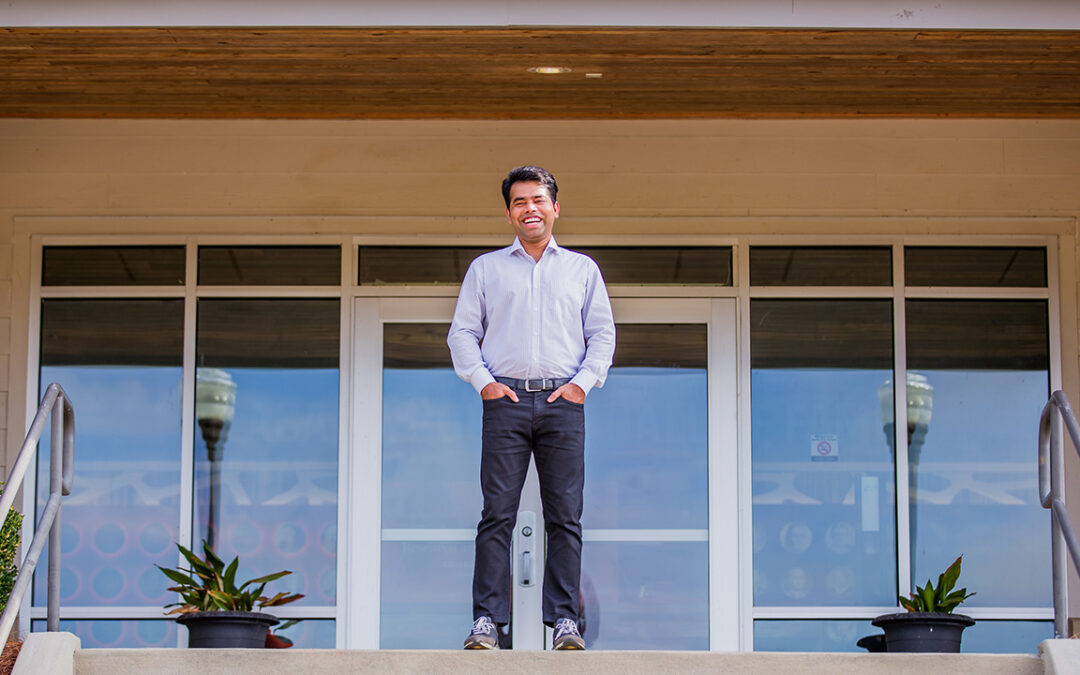Live poultry production in the U.S. is on the cusp of revolutionary changes, and Auburn University’s National Poultry Technology Center, or NPTC, is helping to ensure that producers are not left behind.
“Efficiency is the key to everything we do,” said Gene Simpson, NPTC associate director, extension specialist and professor of agricultural economics and rural sociology. “We have marvelous genetics for birds, and our job in live production is to extract as much of that genetic potential as possible for the least cost.”
Playing a major role in facilitating these changes is the NPTC’s new outreach, demonstration and applied research facility, the only facility in the nation dedicated solely to testing and refining equipment to improve poultry farming efficiency and profitability. The facility is located at the new Charles C. Miller Jr. Poultry Research and Education Center, north of Auburn’s main campus.
The facility is a multiuse 66- by 250-foot teaching and applied research building supporting the many on-campus activities of the NPTC. It can accommodate group training sessions of up to 130 participants with the option of small-group hands-on training by participants utilizing instrumentation, measurement and other demonstration techniques.
Since the building’s opening in May 2017, eight major industrywide grower workshops and related tours and schools have been held, training more than 950 industry employees and growers. A number of additional schools are planned in the coming months.
“We’ve conducted a tremendous number of applied research studies in the field over the past 15 to 20 years without a facility,” Simpson said. “Now we have a facility just for this purpose. We try to cater to what the live poultry production industry is demanding, and that demand is driving our applied research and teaching. The overall goal is to reduce grower operating costs and improve bird performance.”
The faculty of the NTPC provides growers with a unique combination of engineering and economic expertise not only to demonstrate the most efficient housing and equipment options but also to test the financial feasibility of various systems. The applied research and training facility enables technicians, managers and others in the industry to learn how new and improved technologies work and to practice them to see how the techniques y can improve their own operations.
Lighting, heating, cooling, ventilation and fan efficiency are just a few of the ongoing research projects, Simpson said.
“For fan efficiency in poultry houses, we’re using tachometers for assessment, along with belt, pulley, shutter and belt tensioner care and maintenance,” he said. “We’re also looking at the care and maintenance of heating and evaporative cooling systems.”
Energy-efficient lighting with LEDs also is a focus of research, as poultry houses move away from incandescent, fluorescent and high-pressure sodium vapor lights.
“Lighting goals and needs are very different for broilers, pullets (young hens) and breeder hens,” Simpson said. “House size and bird size dictate optimal lighting layout design, bulb selection and operation.”
Water quality for bird consumption and evaporative cooling is another relevant issue receiving attention, he said, with well water being highly variable in pH, minerals and salts. Periodic testing, even for municipal sources, —is recommended, along with the proper selection and use of commercial chemicals and other additives.
With generators being the lifeblood of the poultry farm, research and education also is focusing on annual servicing, fuel, filters, trouble-shooting problems and following a regular maintenance checklist, Simpson said.
“The industry relies on us to help determine where those small increments of potential improvement might be,” he said. “If it’s something that provides improvement in feed conversion, companies will do everything they can to help growers gain that improvement, and they typically will offer incentives to growers to see that hose changes occur.”
Through energy efficiency, improved feed efficiency and improved poultry housing structures and insurability, the NPTC directly contributes more than $40 million annually to Alabama’s poultry industry and its growers, Simpson said.
The NTPC facility also is used for teaching Auburn University students who are enrolled in commercial poultry and livestock housing courses.
“By allowing students to conduct hands-on lab exercises in the NPTC building, we are ensuring that our graduates have experience with a wide array of poultry house equipment and controllers before they leave Auburn and take their first job in the industry,” Simpson said. “Integrators tell our faculty that recent graduates who have been trained are ready to go to work, and the learning curve for them is much less steep.”
To date, 58 undergraduate students have participated in classes, and three graduate students are conducting their research in the facility. Three undergraduate students are also conducting senior-level research projects at the NPTC facility.
Within the next year, a totally off-the-grid poultry farm—operated solely by solar power—will possibly be in operation in Alabama, and that’s only the beginning of the technological advances to come in live poultry production, Simpson said.
“That’s just one of the visions for the future,” he said. “The limiting factor is battery technology, but we’ll eventually get it done.”
The technology also is available to allow growers to remotely manage poultry houses with their cell phones, Simpson said.
“The limitation up to now has been the broadband capability, but the current political climate is favorable for expanding rural broadband coverage, and we should see the implementation of technologies that have been stymied by bandwidth imitations.”
Low-cost, reliable sensors will be able to monitor in-house conditions and transmit those findings to a controller, where a decision algorithm will allow it to turn certain components on or off, maintaining an ideal growing environment. These improved environmental conditions will mean more bird comfort and less likelihood of disease in poultry houses.
The future of live poultry production also is being driven by consumer demands, Simpson said, with nearly half of U.S. production currently being raised without antibiotics.
“If consumers tell the local fast-food chain that they want nothing but antibiotic-free chicken, then the fast-food chain will demand that from its supplier,” he said. “This has caused a tremendous amount of field research activity. Probiotics and other supplements are being added to prevent disease from becoming a problem.”
Part of the problem, Simpson said, is that growers raise birds on built-up manure, increasing the bacterial load and disease challenge.
“We are envisioning a chicken house with an elevated, plastic-slate floor, with birds on agrate or panel, and the waste falling through to a concrete floor,” he said. “Growers can clean off the floor between flocks with an automatic scraper system and minimize disease problems.”
In addition to Simpson, other members of the NPTC team include director Jim Donald, associate director Jeremiah Davis and extension specialists Jess Campbell and Dennis Brothers. For more information, go to http://www.aces.edu/poultryventilation/contacts.php




